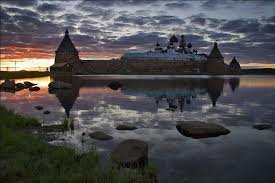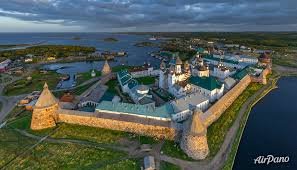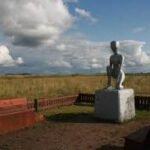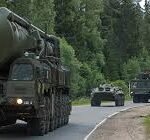Rising from the icy waters of Russia’s White Sea, the Solovetsky Islands (commonly called Solovki) present a dramatic paradox – a sacred Orthodox monastery that became one of the Soviet Union’s most notorious prison camps. This remote archipelago of six islands has served as a spiritual center, military fortress, and island gulag over its 600-year history, accumulating layers of legend and tragedy. The islands’ massive stone monastery walls enclose both golden-domed churches and the ghosts of Stalin’s repression, while the surrounding landscape holds ancient stone labyrinths older than the Egyptian pyramids. Modern visitors report strange phenomena – from mysterious lights in the monastery corridors to the persistent feeling of being watched in the abandoned prison barracks.
The Sacred Origins of Solovetsky Islands Monastery
Founded in 1429 by Orthodox monks Savvaty and Herman, the Solovetsky Monastery grew into one of Russia’s most important spiritual centers. What began as a simple wooden chapel evolved into an imposing stone fortress that withstood attacks by Livonian Knights and Swedish forces. The monastery’s unique microclimate allowed monks to cultivate exotic plants in northern Russia’s first botanical garden, while their ingenious freshwater system connected 185 lakes. During the 16th century, the monks constructed massive boulder walls up to 8 meters thick using a mysterious ancient technique – no mortar, yet perfectly fitted stones that have survived centuries of Arctic storms. The monastery’s wealth grew from saltworks and pilgrim donations, creating a semi-independent theocratic state that minted its own coins and maintained a small army.
From Holy Site to Hellish Gulag of Solovetsky Islands
The monastery’s dramatic transformation began in 1920 when the Bolsheviks established the SLON (Solovetsky Special Purpose Camp), the prototype for the Soviet gulag system. What had been cells for religious ascetics became punishment blocks for intellectuals, clergy, and political prisoners. At least 7,000 people died here under horrific conditions – worked to death building the White Sea-Baltic Canal, frozen in unheated barracks, or executed in the isolated Sekirnaya Hill torture chamber. The camp gained particular infamy for its “psychological torture” methods; guards would force prisoners to pretend they were trains, complete with whistle sounds, or stand naked in formation during Arctic blizzards. Alexander Solzhenitsyn later documented these atrocities in “The Gulag Archipelago,” ensuring Solovki became synonymous with Soviet repression.
The Mysterious Stone Labyrinths
Scattered across the islands’ shores lie about 35 stone labyrinths dating back 3,000-5,000 years, their purpose lost to time. These spiral formations of local boulders, some measuring 25 meters across, show remarkable similarity to Bronze Age labyrinths found in Scandinavia. Local Pomors believed them to be “Babylon’s” – traps for evil spirits, while Soviet archaeologists speculated they were ancient fishing traps or astronomical calendars. Modern researchers note strange electromagnetic readings at labyrinth centers, and some visitors report disorientation or visions when walking the paths. The most intact labyrinth on Big Zayatsky Island sits beside 600 mysterious stone cairns, creating a landscape that feels eerily ritualistic even today.
Ghosts of the Gulag Archipelago
Former prisoners’ accounts describe numerous supernatural occurrences that continue to this day. Guards reported seeing phantom monks walking the walls at night, while prisoners spoke of “the Weeping Woman” – a spectral nun heard sobbing near the former torture chambers. Modern staff at the restored monastery avoid certain corridors after dark, claiming to hear whispered prayers in empty rooms. Psychics who visited in the 1990s described the islands as “saturated with pain,” detecting energy vortices near mass grave sites. Most chilling are the recurring reports of “shadow prisoners” – dark figures seen shuffling in work brigades along abandoned logging roads, vanishing when approached.

Engineering Marvels of the Monk-Builders
Beyond its spiritual significance, the monastery represents an extraordinary feat of northern engineering. Monks constructed a system of interlocking canals between islands that allowed small boats to traverse the archipelago, along with underground passages linking key buildings. Their most impressive achievement was a 19th-century hydroelectric plant – Russia’s first – powered by tidal flows from the White Sea. The monks also pioneered Arctic agriculture, using seaweed fertilizer to grow watermelons at 65° north latitude. During the Crimean War, they mounted century-old cannons on the walls that successfully repelled British warships, making Solovki the only monastery to receive a military medal from the Tsar.
The Islands’ Bizarre Natural Phenomena of Solovetsky Islands
Solovki’s microclimate creates unusual natural occurrences. In summer, the “White Nights” bring 24-hour daylight when the sun barely dips below the horizon, casting an eternal golden glow. Winter brings the opposite – the “Polar Nights” of perpetual twilight from November to January. The surrounding waters sometimes exhibit the “Dead Water” effect, where boats mysteriously lose speed due to layered salinity. Local fishermen tell of “singing sands” on certain beaches that emit musical tones when walked upon. Most spectacular are the winter ice formations – waves freeze mid-motion, creating surreal sculpted walls of blue ice along the shores.
Modern Pilgrimage and Dark Tourism
Since the monastery’s restoration in 1990, Solovki has become both a spiritual destination and a site of historical reckoning. Orthodox pilgrims come to venerate the relics of Saint Philip, who was martyred by Ivan the Terrible, while others seek out the “Tears of the Virgin” icon said to weep miraculously. Meanwhile, descendants of gulag victims leave memorial stones at Sekirnaya Hill, where the original wooden cross was rebuilt using nails salvaged from prison barracks. The islands now host an annual “Solovki Encounter” gathering that brings together former prisoners, historians, and artists to reconcile this dual legacy. Visitors can stay in former monk cells converted to guest rooms, where some report vivid dreams of the islands’ past lives.
Preserving Solovetsky Islands Memory in Russia’s Remote North
The Solovetsky Islands today face the delicate task of balancing preservation with accessibility. Designated a UNESCO World Heritage Site in 1992, the monastery undergoes constant restoration while archaeologists work to document the labyrinths before erosion claims them. Rising tourism (now about 30,000 visitors annually) brings economic hope but also threats to the fragile ecosystem. Most poignant are the ongoing efforts to identify gulag victims from mass graves discovered in the 2000s, giving names to the anonymous dead. As Russia grapples with how to remember its Soviet past, Solovki stands as both warning and wonder – a place where spiritual light and human darkness exist side by side in the Arctic silence.
The Solovetsky Islands continue to captivate all who visit – whether drawn by faith, history, or mystery. This remote archipelago holds layers of stories in its stone walls: of medieval monks seeking God in the wilderness, of prisoners finding despair in the same cells, and of modern seekers trying to understand this profound collision of sacred and profane. Perhaps this is Solovki’s ultimate lesson – that no place is purely holy or wholly damned, but that all ground is hallowed by human experience and suffering. As the White Sea’s waves crash eternally against these storied shores, the islands stand as silent witnesses to Russia’s complex soul.
Go to main page


